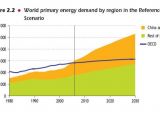International Energy Agency's (IEA) World Energy Outlook 2008 report, the latest annual document released, paints a bleak image of the future of energy worldwide. The paper says that energy demands will constantly increase in the next couple of decades, which will lead to a planetary increase in temperature, by about 3 degrees Celsius. In order to prevent this, humankind must find a way to drop carbon emissions drastically, and move to clean (not cleaner) energy sources.
"Current trends in energy supply and consumption are patently unsustainable – environmentally, economically and socially – they can and must be altered," warned IEA executive director, Nobuo Tanaka, at the release of the document. Though oil prices have decreased lately, this is not a good sign, as it may appear. Prices per barrel were driven down artificially, by the lack of demand. But production costs are increasing and extraction becomes more and more difficult. That's why the report says that the "era of cheap oil is over."
The paper went on to add that "It is not an exaggeration to claim that the future of human prosperity depends on how successfully we tackle the two central energy challenges facing us today: securing the supply of reliable and affordable energy; and effecting a rapid transformation to a low-carbon, efficient, and environmentally benign system of energy supply. What is needed is nothing short of an energy revolution."
Rising economies in Asia, mostly China and India, will drive up demand considerably, more than Organization for Economic Cooperation and Development OECD and non-OECD countries combined. In order to supply more energy to these countries, producers will have to use more and more fossil fuel, which will, in turn, affect the environment even further.
The Outlook says that 0.2 percent of the world GDP would suffice to tackle the problem of carbon in the atmosphere successfully. This adds up to some $4.1 trillion, which is quite an amount to centralize and distribute to affected areas. However, the report seems to show that an international cooperative effort is the only solution to discontinuing the use of coal, oil and natural gases for energy production.

 14 DAY TRIAL //
14 DAY TRIAL // 
